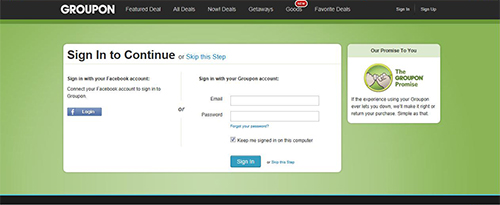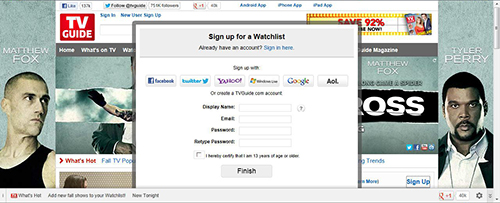The Marketing Miracle of Social Sign-On
Social sign-on, also called social login, is a form of single sign in to a third-party website using existing login information from a social network like Facebook, LinkedIn, Foursquare or Twitter. This way, users can avoid creating a new login ID and password specifically for that brand’s website.
This is one of those brilliant marketing tools where everyone benefits. The prospect gets a faster, easier way to enter a contest, sign up for a promotion, or make a purchase. The marketer gets higher response rates, due to the convenience. The marketer also benefits from receiving extra data about the prospect based on the social media profile, allowing a more tailored experience at the brand’s site. A win-win.
Another reason why social sign-on works so well is because so many consumers forget the user name and passwords for accounts they have set up. A recent report from Janrain says that 90% of consumers will leave the site when they can’t remember how to log in, instead of submitting a request to recover the login information.
Also, when being asked to register, some consumers will provide false information, which does the marketer no good. The Janrain study suggests that as many as 88% of registrations these days are faulty or incomplete, up from 76% the prior year.
But the big problem for marketers is consumers’ increasing unwillingness to create an account at websites. Only 14% of visitors will complete a registration form, according to the Janrain study. Instead, 54% say they leave the site and not return; and 26% will go to an alternate site, if possible. Clearly, account sign-on is a problem for consumers, and the wasted opportunity is a loss for both consumers and marketers alike.
Illustration caption: Social couponer Groupon invites users to sign in using their Facebook accounts, which is much faster than filling in their email addresses and Groupon passwords.

Perhaps the most compelling reason to include social sign-on is the data that comes along with the consumer’s entry to the website. Profile information about user behavior allows marketers to create more relevant messaging, which in turn means higher sales and increased likelihood of repeat visits and purchases. Responders in the Janrain study said they were more likely to return to the website (50%) and more likely to buy products and services (46%) if their experience on the site is personalized.
The data from social networks carried to websites via social sign-on varies considerably by network. LinkedIn provides the largest variety of data points, with 12 elements (name, company, location, headline, industry, associations, connections, interests, honors, specialties, and skills). Twitter offers marketers 7 elements: name, tweet count, follower count, language, location, time zone, and Twitter ID. Facebook only offers name, location, gender and birthday.
You can store the acquired from social sign-on data on your database for future use. These data elements might have taken a website years to capture, and can be applied immediately. For example, birthday, which comes with Facebook sign-on, can be used to send annual greetings or promotions on a triggered basis.
When offered a choice, consumers tend to prefer Facebook as their login vehicle. Facebook delivered 61% of the visitors using social sign-on. But of course this means that nearly 40% of social sign-ons were delivered through other networks, so marketers should consider offering several network options, in order to increase response rates.
Chart: Consumers now prefer social sign-on to other forms of accessing accounts.
| Percent of 566 responders | |
| Use social login | 41% |
| Create new account | 35% |
| Use guest account | 24% |
Source: Janrain study, in response to the question: Assuming for a moment that you were at a secure website from a well-established company that offers content or sells products/services that interest you and you were at a point where you needed to either create a new account, use a guest account or use “social login,'” what are you most likely to do?
To determine which networks to offer as a substitute for individual login, start by considering the social-sharing habits of your customers. Also look at the social networks your company is most engaged in and which are your top strategic priorities. Then, select a generous list of social networks to test, and refine from there. Once you start collecting data on which social networks people are signing in with, you can use that data to develop your ongoing social media strategy.
When it comes to results from offering social sign-on at your website, data from a study by the social media marketing platform Gigya tells an impressive story:
- Users logged in with a social network spent 50% more time on the website (12 minutes, versus 8 minutes).
- They viewed on average 10 pages, versus 5 pages with standard login.
This is great business for everyone.

TVGuide.com offers sign-in not only via social media, but also by Internet service provider, like AOL, Yahoo and Google.


